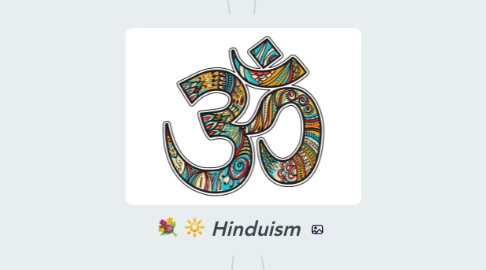
1. Practice
1.1. Ritual
1.1.1. Mantra: a sacred word or phrase that is chanted during worship or meditation
1.1.2. Puja: a form of thanksgiving in which offering are made to the deities.
1.1.2.1. Shrine
1.1.2.1.1. Offerings of Flower
1.1.2.1.2. Offerings of Fruit
1.1.2.1.3. Lamp
1.1.2.1.4. Carpet
1.1.2.1.5. Candles
1.1.2.2. Worship at home
1.1.2.2.1. Picture of Shiva Nataraja
1.1.2.2.2. Oil Lamp and Ghee Holder
1.1.2.2.3. Book of Scriptures
1.1.2.2.4. Bell
1.1.2.2.5. Offerings of Fruit
1.1.2.2.6. Offerings of Flowers
1.1.2.2.7. Prayer beads
1.1.2.2.8. Incense sticks
1.1.2.2.9. Photograph of guru
1.1.2.2.10. OM symbol
1.1.2.2.11. Bells
1.2. Pilgrimages
1.3. Symbols & Icons
1.3.1. OM is changed at the beginning and end of all Hindu prayers and reading of scriptures.
1.3.2. Swastika is gook luck 'well-being'
1.3.3. Tilaks is horizontal for worshippers of Shiva and vertical for worshippers.
1.4. Festivals
1.4.1. Diwali (The festivals of lights)
1.4.2. Holi (The festivals of colors)
2. Caste system
2.1. Varnas
2.1.1. Brahmins (priests, teachers, judges): performance of rituals and sacri-fices, pursuit of arts, sciences, ethics, philosophy and religious study, research and teaching.
2.1.2. Kshatriyas (warriors): goverment, maintenance of law and order, protection from foreign invaders.
2.1.3. Vaisyas (farmers and merchants): management of wealth, trade with other societies.
2.1.4. Sudras (craftworkers and laborers): service to other castes.
2.2. Dharma
2.2.1. Sanatana
2.2.1.1. Ahimsa
2.2.1.2. Satya
2.2.1.3. Asteya
2.2.1.4. Sauca
2.2.2. Varna Ashrama
2.2.2.1. Brahmacharya - Student: discipline mind and body, gain knowledge, learn rules and rituals of Hinduism, show respect toward elders.
2.2.2.2. Grihastha - Householder: marry and have a family, provide for the family, give to charity, care for family elders, practise social and religious traditions.
2.2.2.3. Vanaprastha - Forest Dweller: retire and transmit household duties to wife or son, read and study, participate in religious pilgrimages.
2.2.2.4. Sannyasin - Renouncer: give up worldly life, wander, meditate, attain salvation.
2.3. Karma
3. Trimurti Brahman
3.1. Brahma (The creator) is the least worshipped of the three main gods.
3.2. Shiva (The destroyer) is worshipped by about a quarter of all Hindus, he controls death.
3.2.1. The Ganges River
3.2.2. Varanasi
3.2.3. Shakti
3.2.4. Parvati
3.2.5. Lakshmi
3.2.6. Shaivism
3.3. Vishnu (The preserver) is worshipped under several names. This is because he has different appearances.
3.3.1. Ram Avatar (Lord of Principe)
3.3.2. Krishna Avatar (Lord of Politics)
3.3.3. Buddha Avatar (Lord of Peace)
3.3.4. Vaishnavism
4. Hinduism beliefs
4.1. Core Beliefs
4.1.1. Brahman is a metaphysical concept of Hinduism referring to the ultimate reality.
4.1.2. Atman a Hindu word that means 'soul or spirit'.
4.1.3. Karma: basic belief of cause and effect (all actions have a consequence)
4.1.4. Moksha: the liberation from samsara and the uniting of Atman (human soul) with Brahman (ultimate soul)
4.1.4.1. Bhakti Yoga (the path of devotion)
4.1.4.2. Karma Yoga (the path of action)
4.1.4.3. Jnana Yoga (the path of wisdom)
4.1.4.4. Raja Yoga (the path of meditation)
4.1.5. Vedas means knowledge which originates from Brahman.
4.1.5.1. Rig Veda
4.1.5.2. Sama Veda
4.1.5.3. Yajur Veda
4.1.5.4. Atharva Veda
4.1.6. Cyclical Time
4.1.7. Dharma (personal conduct and righteous living)
4.1.8. Reincarnation
4.1.9. Samsara: endless cycle of reincarnation
4.1.9.1. Birth
4.1.9.2. Death
4.1.9.3. Rebirth
4.2. Denominations
4.2.1. The Epics (Smriti) are popular vehicles for spreading Hindu ideals of moral conduct.
4.2.1.1. Mahabharata part of it is the Bhaghavad-Gita which is set during the Mahabharata war.
4.2.1.2. Ramayana is the story of Price Rama, who is worshipped throughout the Hindu world as the seventh avatar or incarnation of the gob Vishnu.
